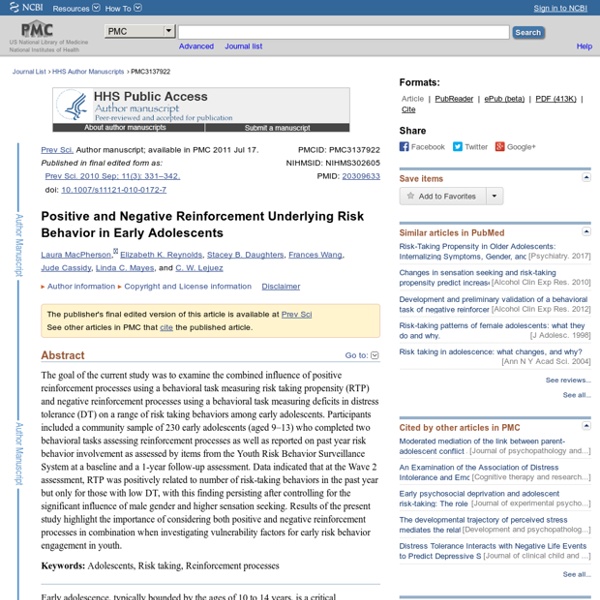



https://www.ncbi.nlm.nih.gov/pmc/articles/PMC3137922/
Related: Reinforcement and Punishment on Teenagers: A Guide for Parents • geetha009The Study of Punishment in Psychology Punishment is a term used in operant conditioning to refer to any change that occurs after a behavior that reduces the likelihood that that behavior will occur again in the future. While positive and negative reinforcements are used to increase behaviors, punishment is focused on reducing or eliminating unwanted behaviors. Punishment is often mistakenly confused with negative reinforcement. The difference: Reinforcement increases the chances that a behavior will occur and punishment decreases the chances that a behavior will occur.
Simple reward-based learning suits adolescents best Adolescents focus on rewards and are less able to learn to avoid punishment or consider the consequences of alternative actions, finds a new UCL-led study.The study, published in PLOS Computational Biology, compared how adolescents and adults learn to make choices based on the available information. 18 volunteers aged 12-17 and 20 volunteers aged 18-32 completed tasks in which they had to choose between abstract symbols. Each symbol was consistently associated with a fixed chance of a reward, punishment or no outcome. Schedules Of Reinforcement - Psychology Schedules of reinforcement can affect the results of operant conditioning, which is frequently used in everyday life such as in the classroom and in parenting. Let’s examine the common types of schedule and their applications. Schedules Of Reinforcement Operant conditioning is the procedure of learning through association to increase or decrease voluntary behavior using reinforcement or punishment.
Negative Reinforcement as a Parenting Technique You've heard of negative reinforcement, but how do you put it into practice? These 4 negative reinforcement examples will explain how. You've probably heard terms like "negative reinforcement" and "positive reinforcement" thrown around a lot during the course of your parenting career. 12 Examples of Positive Punishment & Negative Reinforcement You might be thinking that “positive punishment” sounds like an oxymoron, after all, how can punishment be positive? Not many people “like” punishment, right? The disconnect in understanding this concept comes from the usage of the word “positive;” here at PositivePsychology.com, we generally use the term “positive” to refer to things that are inherently good, things that are life-giving, and things that promote thriving and flourishing.
Using Positive Reinforcement to Improve Behavior When your child misbehaves, rewards might be the last thing on your mind. But, positive reinforcement can be one of the most effective behavior modification techniques.1 You can use positive reinforcement to encourage prosocial behaviors, like sharing or following directions. And, you can use it to prevent misbehavior, like hitting and rule violations. What Is Operant Conditioning and How Does It Work? Operant conditioning, sometimes referred to as instrumental conditioning, is a method of learning that employs rewards and punishments for behavior. Through operant conditioning, an association is made between a behavior and a consequence (whether negative or positive) for that behavior.1 For example, when lab rats press a lever when a green light is on, they receive a food pellet as a reward. When they press the lever when a red light is on, they receive a mild electric shock. As a result, they learn to press the lever when the green light is on and avoid the red light.
Parenting Children with Positive Reinforcement (Examples + Charts) Children don’t come with instructions and discipline is often experienced by parents and children alike as an arena where our will and wits are tested. Positive reinforcement is only one of many forms of discipline, but from the perspective of positive psychology, it may as well be the most important one as it focuses on amplifying what is already good in our children and in ourselves as their caretakers. Positive reinforcement as a form of positive discipline allows us to tap into our children’s individual strengths, draw attention to their personality traits and interests, and as a result give us an opportunity to connect, communicate effectively, and ultimately empower them to be more of themselves. Before you read on, we thought you might like to download our 3 Positive Psychology Exercises for free.
Positive vs. Negative Reinforcement: A Guide for Parents I almost stopped bringing them to the playground. With two children under the age of 4, playgrounds had been a place of respite for me. I could sit on the bench and catch up with some parent friends while my littles jumped, slid, and climbed to their heart's content in a controlled setting. We could all let off a little steam there, but leaving the playground had become such a process that I almost stopped going altogether.